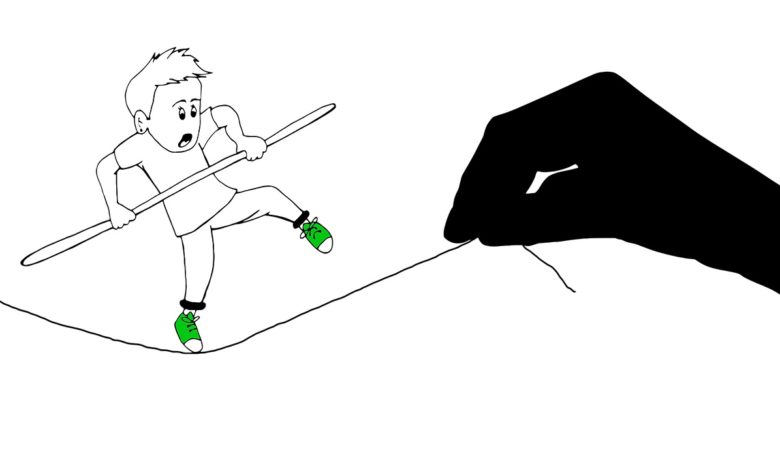The Federal Reserve Is Walking a Tightrope in a Hurricane

The Federal Reserve is trying to walk a tightrope — in a hurricane.
After rate hikes resulted in the collapse of Silicon Valley Bank and Signature Bank, the Federal Reserve and the US Treasury stepped in with a bailout. With that hole in the dam seemingly plugged for the time being, the Fed pushed forward and raised interest rates by another 25 basis points at its March meeting.
In effect, the bank bailout ended the inflation fight while allowing the Fed to continue the pretense of an inflation fight for a little while longer.
THE RATE HIKE
At its March meeting, the FOMC raised interest rates by another quarter percent. That brings the target range for the Fed funds rate to between 4.75 and 5%. It was the ninth consecutive rate increase.
The official FOMC statement asserted that the “US banking system is sound and resilient.”
It also noted that inflation “remains elevated.”
CPI came in at 6% in February. Although the CPI has ticked down in recent months, it remains closer to the 2022 highs than it does the 2% Fed target.
The FOMC statement indicated that “the Committee anticipates that some additional policy firming may be appropriate in order to attain a stance of monetary policy that is sufficiently restrictive to return inflation to 2 percent over time.”
But it removed language from the statement saying the committee expects “ongoing increases” and replaced it with a line saying the committee “will closely monitor incoming information and assess the implications for monetary policy.”
This was widely viewed as a doveish indication that the Fed might be close to the end of rate hikes.
But the statement emphasized that “the Committee is strongly committed to returning inflation to its 2 percent objective.”
During the post-meeting press conference, Powell indicated that the banking crisis may actually help the Fed beat down inflation by tightening lending conditions.
Or maybe not.
It’s possible that these events will turn out to be very modest effects on the economy, in which case inflation will continue to be strong, in which case, you know, the path might look different. It’s also possible that this potential tightening will contribute significant tightening in credit conditions over time. And in principle, that means that monetary policy may have less work to do. We simply don’t know.”
The 25 basis point rate hike was widely anticipated. With price inflation still running far above the target, the Fed couldn’t plausibly pivot and end rate hikes. But make no mistake, the inflation fight ended the moment the central bank created the bank bailout program.
SOMETHING BROKE
The collapse of SVB and Signature Bank were the first things to break as a result of Fed tightening.
They won’t be the last.
As I’ve been saying for months that this was inevitable. This bubble economy is built on artificially low interest rates and money creation. The Fed took some of that away when it started tightening monetary policy. In effect, the central bank has dug the foundation out from under the economy and the financial system. You can’t undermine a foundation without eventually causing the entire building to collapse.
During his post-FOMC meeting press conference, Powell tried the paint the collapse of SVB and Signature Bank as “an outlier.”
“These are not weaknesses that are at all broadly through the banking system,” Powell claimed.
This is simply false.
In fact, the collapse of SVB and Signature Bank was the tip of the iceberg. According to a Washington Post report, hundreds of banks are at risk because the Fed rate hikes have decimated the value of bonds held by these banks.
According to the Post, the capital buffer in the US banking system totals $2.2 trillion. Meanwhile, total unrealized losses in the system based is between $1.7 and $2 trillion.
In other words, if banks were suddenly forced to liquidate their bond and loan portfolios, the losses would erase between 77 percent and 91 percent of their combined capital cushion. It follows that large numbers of banks are terrifyingly fragile.”
The fact that the Fed loaned banks some $300 billion in the first week of the bailout indicates the problem wasn’t “an outlier.”
KICK THE CAN DOWN THE ROAD
The Fed executed a shrewd move with its bank bailout. It created a way to mitigate the impact of interest rate hikes on bank balance sheets without having to lower interest rates more broadly
After the failure of Silicon Valley Bank, the Federal Reserve announced a loan program that will allow other banks to easily access capital “to help assure banks have the ability to meet the needs of all their depositors.”
The Bank Term Funding Program (BTFP) will offer loans of up to one year in length to banks, savings associations, credit unions, and other eligible depository institutions pledging US Treasuries, agency debt and mortgage-backed securities, and other qualifying assets as collateral. Banks will be able to borrow against their assets “at par” (face value).
According to a Federal Reserve statement, “the BTFP will be an additional source of liquidity against high-quality securities, eliminating an institution’s need to quickly sell those securities in times of stress.”
Keep in mind, banks are struggling precisely because the Fed raised interest rates so fast after holding them at zero for so long. As Peter Schiff noted, “It was the Federal Reserve that created all these distortions by its artificial suppression of interest rates, and it caused financial institutions to take incredible risks in order to get a return.”
With this loan program in place, banks can access capital based on their devalued bond holdings without selling their Treasuries and mortgage-backed securities into the market at a big loss (as SVB was forced to do). This provides some stability for both the banks and the bond markets.
This is how the Fed was able to raise interest rates and make a show of staying in the inflation fight. It can even keep shedding Treasuries and mortgage-backed securities from its balance sheet. Meanwhile, the banks can avoid the pain by accessing this crazy loan program. In effect, it can have its cake and eat it too – at least for a little while.
I think Powell and Company are hoping this loan boondoggle will buy them time to keep tightening for a while longer in the hope that CPI will drop enough in the next couple of months to claim victory over inflation and then pivot without losing face.
THE INFLATION FIGHT IS OVER
But make no mistake, no matter what Powell says, the inflation fight is over.
You don’t fight inflation by handing banks $300 billion of money created out of thin air. The purpose of monetary tightening is to squeeze liquidity out of the system. This loan program does the opposite. It injects liquidity into the system. It is the exact opposite of inflation fighting. It literally creates inflation.
Furthermore, it’s only a matter of time before something else breaks in the economy or the financial system. Banks aren’t the only things being impacted by increasing interest rates. Corporations are levered to the hilt. The federal government continues to borrow and spend, running up its debt. American consumers have buried themselves under record credit card debt. The entire economy is based on artificially low interest rates.
And the Fed just raised rates again.
The Fed may have managed to get a finger in one crack in the dam — for now — but it won’t be long before another hole appears. And then another. And then another.
It’s only a matter of time before the Fed has to abandon the pretense of an inflation fight, pivot, and start cutting rates.
In other words, inflation has won.
But for now, Powell and Company can continue to pretend to be tough on inflation. It can keep walking the tightrope. But tightrope walking in a hurricane is doomed to fail.
Call 1-888-GOLD-160 and speak with a Precious Metals Specialist today!
Buka akaun dagangan patuh syariah anda di Weltrade.
Source link






